
Compilation Album
The Hollyridge Strings "The Beatles Song Book" (CP-7112)
(Update: 23th. July 2020)



| TITLE | THE BEATLES SONG
BOOK The Hollyridge Strings |
||||
| CATALOG NUMBER | CP 7112 |
||||
| RELEASE DATE | Test Press (First Press: 15th.
August 1964) |
||||
| TRACK LISTING | SIDE 1 | SIDE 2 | |||
| I Want To Hold Your Hand |
Can't Buy Me love |
||||
| From Me To You |
All My Loving |
||||
| I Saw Her Standing There |
A Taste Of Honey |
||||
| Please Please Me |
She Loves You |
||||
| P.S.I Love You |
Do You Want To Know A Secret? | ||||
| Love Me Do | |||||
| FRONT --> Click! | BACK --> Click! | SIDE 1 --> Click! | SIDE 2 --> Click! | DISK | |
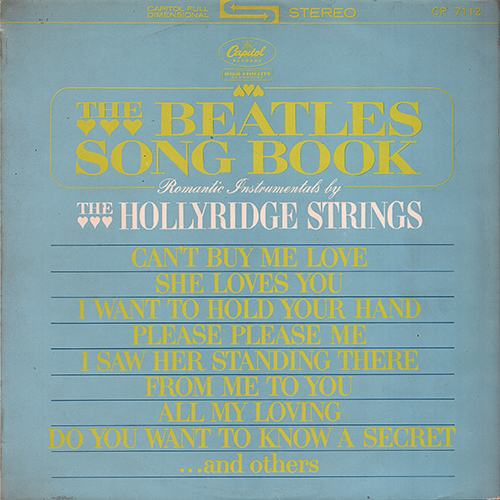 |
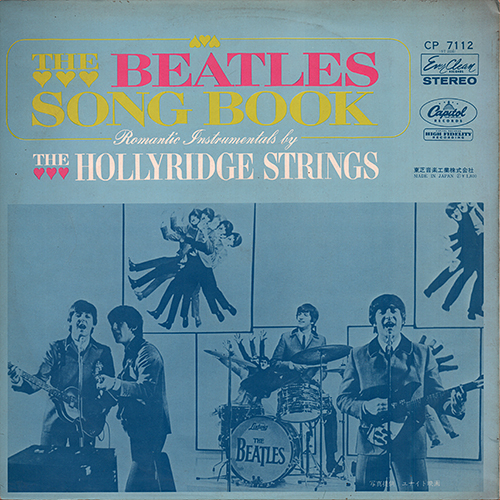 |
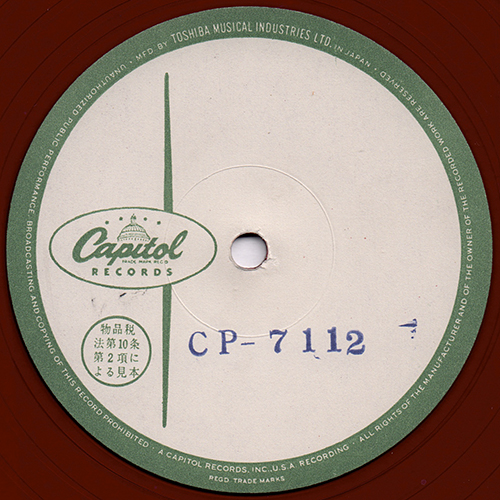 |
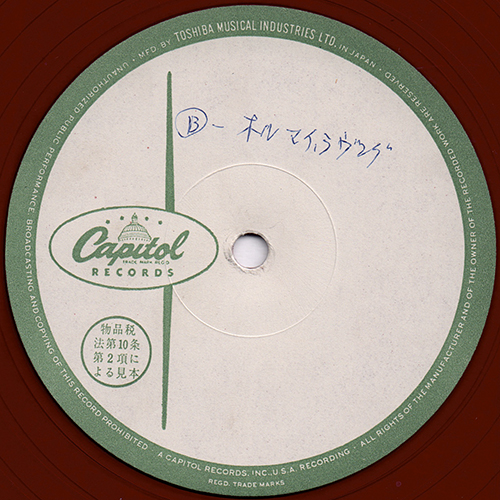 |
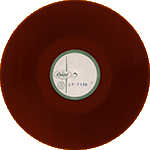 |
|
| INNER SLEEVE |
FRONT COVER CLOSE UP | ||||
| FRONT --> Click! | BACK --> Click! | The
original plain white inner bag has a fold-over flap at the
top of the bag to prevent the record from falling out. |
|||
 |
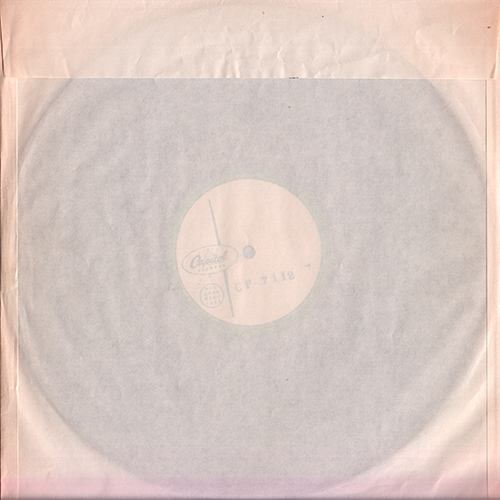 |
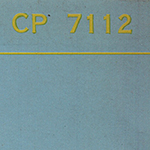 |
Catalogue number "CP 7112"
was printed at the upper right corner of the front. |
||
| FRONT COVER CLOSE UP | |||||
 |
On stereo jackets positioned to reveal the Capitol Full Demensional Stereo arrow logo at the top. | ||||
| FRONT AND BACK COVER CLOSE UP | |||||
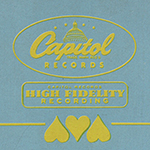 |
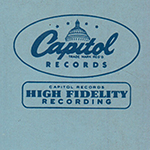 |
The Capitol logo and the phrase "HIGH FIDELITY RECORDING"
appear in lemon yellow at the top of the front and
back cover. Single type. Full laminated soft cover. NO-flipback cover. |
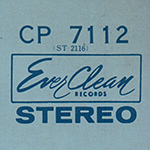 |
Toshiba pressed a lot of
their records on red, “Everclean” vinyl. The Everclean vinyl was designed to be less prone to collecting static electricity and dust than the more common black vinyl. |
|
| BACK COVER CLOSE UP | |||||
 |
"Photo: United
Artists" Credit was printed at the bottom of the back cover. |
||||
 |
"Toshiba Musical Industries Ltd.", "MADE IN JAPAN", and "F-¥1,800" were printed at the bottom of the back cover. | ||||
| LABEL CLOSE UP | |||||
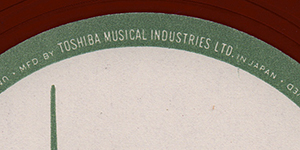 |
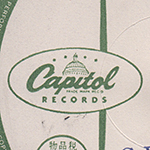 |
Capitol white
label in green ink (test press use only). The words "MFD. BY TOSHIBA MUSICAL INDUSTRIES LTD. IN JAPAN" was printed at the perimeter. |
|||
| LABEL CLOSE UP |
|||||
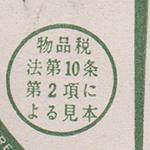 |
Here
is a close-up of the circled text: "Sample under Article 10,
Clause 2 of the Commodity Tax Law". |
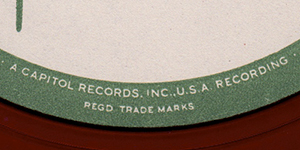 |
The words "A CAPITOL RECORDS, INC., U.S.A. RECORDING" was printed at the perimeter. | ||
| LABEL CLOSE UP | OBI
AND LYRIC SHEET |
||||
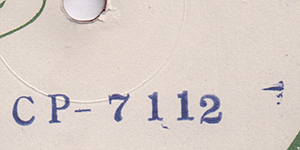 |
Catalogue number "CP-7112"
was stamped in blue ink on the white label. |
NONE |
|||
|
OTHER ITEM
|
|||||
| - |
|||||
| RECORD LABEL | Capitol White Label (for test press use only) | ||||
| MIX | STEREO |
||||
| MATRIX No. | SIDE 1 | ST1-2116-J
1 |
|||
| SIDE 2 | ST2-2116
1 |
||||
| PRESS MARK |
G4 |
||||
| VINYL COLOR | RED | ||||
| RECORD COMPANY'S NAME | SLEEVE |
Toshiba Ongaku
kogyo Kabusikigaisha |
|||
| LABEL |
MFD. BY TOSHIBA MUSICAL INDUSTRIES
LTD. IN JAPAN |
||||
| SYMBOL/PRICE | F - ¥1,800 |
||||
| LYRIC SHEET STYLE | - |
||||
| COVER FORM | Single type. Full laminated soft cover. NO-flipback cover. |
||||
| INNER SLEEVE |
Plain White Inner bag |
||||
| OBI | - |
||||
| COVER DESIGN/ PHOTO/ NOTES | Photo: United Artists | ||||
|
COMMENTS
|
Capitol white label
(Test press use only). The words "MFD. BY TOSHIBA MUSICAL INDUSTRIES LTD. IN JAPAN" was printed at the perimeter. Capitol test LPs feature the perimeter print, Capitol logo, and circled text in green. Catalogue number "CP-7112" was stamped in blue ink on the white label. The label design is similar to that used for the regular commercial Capitol LPs. These are most commonly found on red vinyl. The Hollyridge Strings were an in‐house act released by Capitol Records. Throughout the 1960's, they were perhaps best known for their instrumental versions of Beatles songs. The album was also reviewed in the June 6, 1964, issue of Billboard. This record surprised all critics by climbing to the #15 position in the Billboard album listings (August 22, 1964). As it continued to sell, the success of this album, the Strings' first, prompted Capitol to create a series of songbooks ‐‐ a series for which the band became known. This was Stu Phillips' first record and was the Strings' first attempt at instrumental rock and roll. The Japanese version looks similar to the U.S. version but has a different track listing. |
||||
| TITLE | THE BEATLES SONG
BOOK The Hollyridge Strings |
||||
| CATALOG NUMBER | CP 7112 |
||||
| RELEASE DATE | 15th. August 1964 / First Press |
||||
| TRACK LISTING | SIDE 1 | SIDE 2 | |||
| I Want To Hold Your Hand |
Can't Buy Me love |
||||
| From Me To You |
All My Loving |
||||
| I Saw Her Standing There |
A Taste Of Honey |
||||
| Please Please Me |
She Loves You |
||||
| P.S.I Love You |
Do You Want To Know A Secret? | ||||
| Love Me Do | |||||
| FRONT --> Click! | BACK --> Click! | SIDE 1 --> Click! | SIDE 2 --> Click! | DISK | |
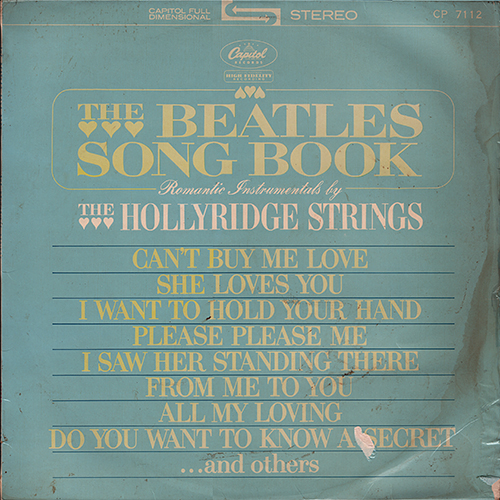 |
 |
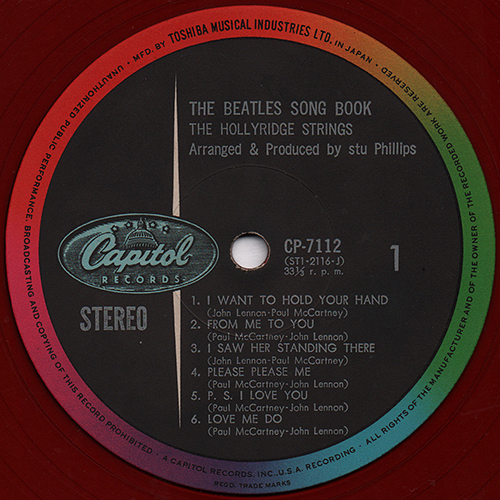 |
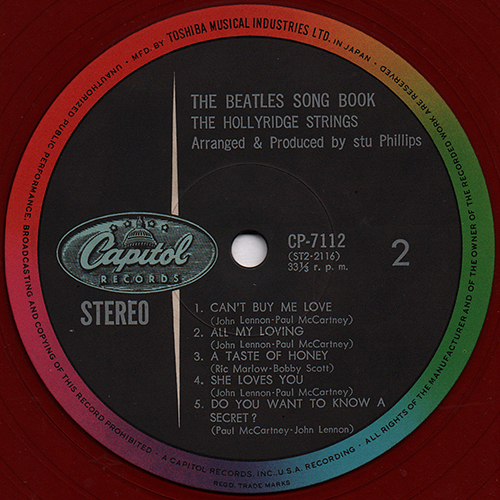 |
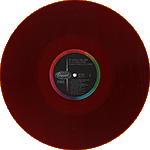 |
|
| INNER SLEEVE |
INNER SLEEVE CLOSE UP | ||||
| FRONT --> Click! | BACK --> Click! | The original colour "advert" inner bag has a fold-over flap at the top of the bag to prevent the record from falling out. | |||
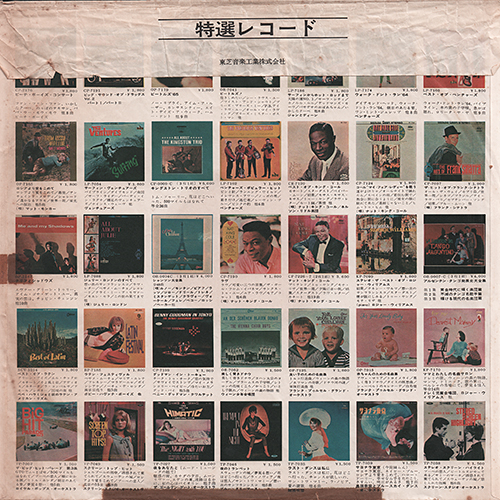 |
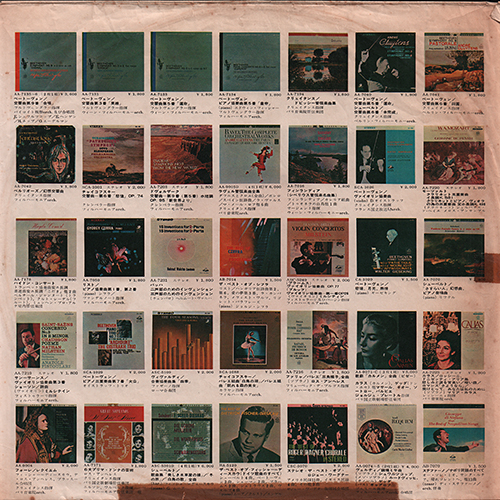 |
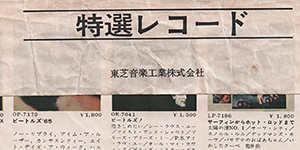 |
|||
| FRONT COVER CLOSE UP | |||||
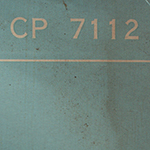 |
Catalogue number "CP 7112" was printed at the upper right corner of the front. |  |
|||
| On stereo jackets positioned to reveal the Capitol Full Demensional Stereo arrow logo at the top. | |||||
| FRONT AND BACK COVER CLOSE UP | |||||
 |
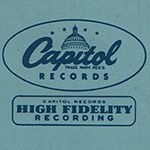 |
The Capitol logo and the phrase "HIGH FIDELITY RECORDING"
appear in lemon yellow at the top of the front and
back cover. Single type. Full laminated soft cover. NO-flipback cover. |
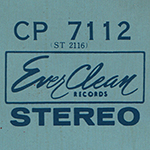 |
Toshiba pressed a lot of
their records on red, “Everclean” vinyl. The Everclean vinyl was designed to be less prone to collecting static electricity and dust than the more common black vinyl. |
|
| BACK COVER CLOSE UP | |||||
 |
"Photo: United
Artists" Credit was printed at the bottom of the back cover. |
||||
 |
"Toshiba Musical Industries Ltd.", "MADE IN JAPAN", and "F-¥1,800" were printed at the bottom of the back cover. | ||||
| OBI: "HANKAKE" OBI | |||||
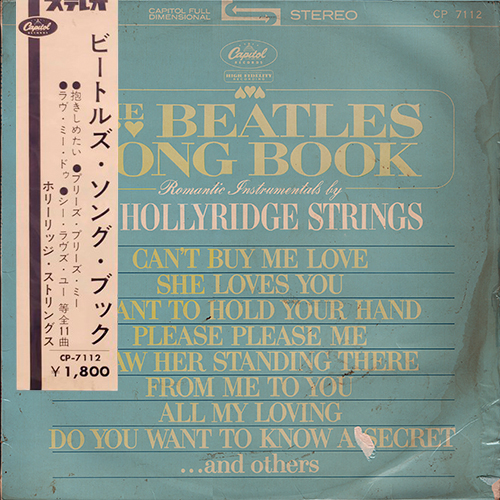 |
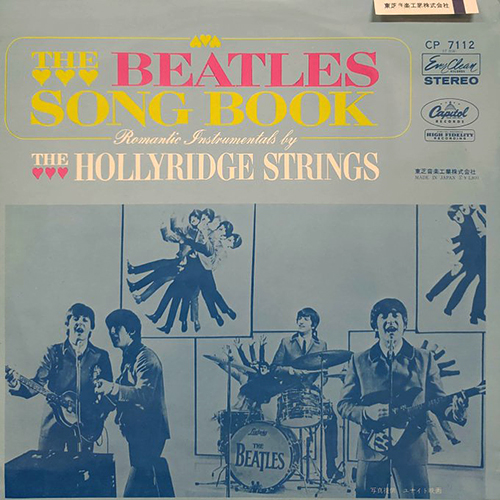 |
In the early 1960s, a
short-lived hankake obi, or “half obi” was used. These
were small strips of paper that simply folded over the top
of the cover. (Sorry, I don't have it.) |
|||
| LABEL CLOSE UP | |||||
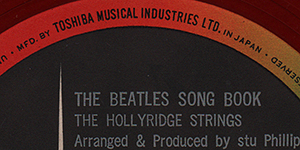 |
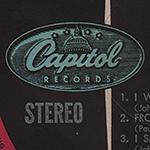 |
Capitol Black label with color
band. The words "MFD. BY TOSHIBA MUSICAL INDUSTRIES LTD. IN JAPAN" was printed at the perimeter. |
|||
| LABEL CLOSE UP |
|||||
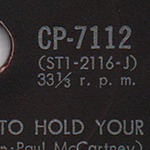 |
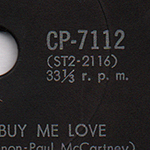 |
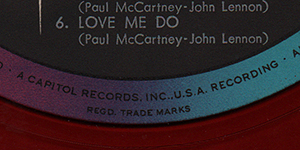 |
The words "A CAPITOL RECORDS, INC., U.S.A. RECORDING" was printed at the perimeter. | ||
|
OTHER ITEM
|
|||||
| - |
|||||
| RECORD LABEL | Capitol Black label with color band | ||||
| MIX | STEREO |
||||
| MATRIX No. | SIDE 1 | ST1-2116-J
1 |
|||
| SIDE 2 | ST2-2116
1 |
||||
| PRESS MARK |
G4 |
||||
| VINYL COLOR | RED | ||||
| RECORD COMPANY'S NAME | SLEEVE |
Toshiba Ongaku
kogyo Kabusikigaisha |
|||
| LABEL |
MFD. BY TOSHIBA MUSICAL INDUSTRIES
LTD. IN JAPAN |
||||
| SYMBOL/PRICE | F - ¥1,800 |
||||
| LYRIC SHEET STYLE | - |
||||
| COVER FORM | Single type. Full laminated soft cover. NO-flipback cover. |
||||
| INNER SLEEVE |
The original colour "advert" inner bag Type-3 | ||||
| OBI | "Hankake" Obi White in design with dark blue Japanese text. Obis draped from the top, not forming a loop. (sorry, I don't have it) |
||||
| COVER DESIGN/ PHOTO/ NOTES | Photo: United Artists | ||||
|
COMMENTS
|
Capitol Black label with color
band. The words "MFD. BY TOSHIBA MUSICAL INDUSTRIES LTD. IN JAPAN" was printed at the perimeter. The Hollyridge Strings were an in‐house act released by Capitol Records. Throughout the 1960's, they were perhaps best known for their instrumental versions of Beatles songs. The album was also reviewed in the June 6, 1964, issue of Billboard. This record surprised all critics by climbing to the #15 position in the Billboard album listings (August 22, 1964). As it continued to sell, the success of this album, the Strings' first, prompted Capitol to create a series of songbooks ‐‐ a series for which the band became known. This was Stu Phillips' first record and was the Strings' first attempt at instrumental rock and roll. The Japanese version looks similar to the U.S. version but has a different track listing. Red vinyl: Besides good sound and quality printing, Japanese records also offered some other things of interest to the collector. One of the primary manufacturing companies in Japan, Toshiba, pressed a lot of their records on red, “Everclean” vinyl from 1958 through 1974 (maybe). While not pressed as collectors’ items, these red vinyl pressings are more sought out by collectors than their black vinyl counterparts. The Everclean vinyl was designed to be less prone to collecting static electricity and dust than the more common black vinyl. The obi: A. K. A."Hankake" Obi It is made from very thin paper stock. It is white in design with dark blue Japanese text. It also features an Odeon logo, catalogue number and price information. These were small strips of paper that simply folded over (glued) the top of the cover. While most Japanese records feature local music, a lot of music fans there like foreign music, as well. The language barrier in Japan presented a problem – should foreign album covers be changed for Japanese albums? The solution was the obi, which means “belt” or “sash”. The obi is a strip of paper, usually about two inches wide, that wraps vertically around the album cover, containing information about the artist and album in Japanese. As these strips of paper were fragile and easily torn, they are often missing, especially since consumers in the 1950s and 1960s attached little significance to them. Finding Japanese records made prior to 1970 that still have the obi intact can be quite difficult, and for some albums, nearly impossible. The inclusion of the obi can dramatically affect the price of some Japanese records, sometimes increasing the price by a factor of ten. While usually found in a wraparound strip, there are other versions of the obi that have occasionally been used. In the early 1960s, a short-lived hankake obi, or “half obi” was used. These were small strips of paper that simply folded over the top of the cover. These were problematic for retailers, as they tended to easily fall off of the record. |
||||
